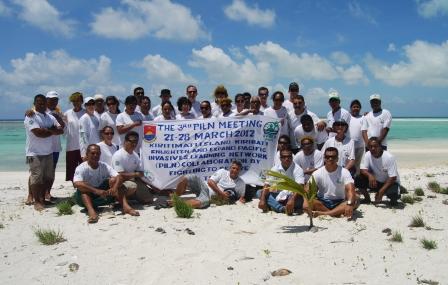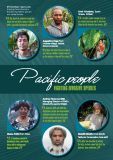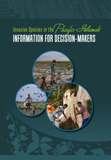PILN MEETING 2016

PILN members gathered in Samoa from 1–5 August for the 4th PILN meeting to celebrate successes, share lessons learned, and create new pathways forward. Check out #PILN2016 on social media to catch up on the news from the meeting. The tags #invasives and #PacificPILN also have information and stories about PILN member actions.
PAST EVENTS
2014:Pacific celebrates successes of CEPF funded projects
- A meeting to celebrate the achievements of 27 invasive species projects in the Pacific islands was held at the Pacific Theological College in Suva, Fiji in 2014.
- Participants from as far east as Easter Island attended the meeting to highlight the impacts of the investment made by the Critical Ecosystem Partnership Fund (CEPF).
- The Macaque Monkeys often portrayed as a poster-child for biodiversity received thumbs down from the Palau delegation after showing images of the damage caused by these introduced animals.
- Over 20 islands were free from rats and cats following eradication efforts led by civil society organizations in partnership with governments. This translates to thousands of birds and other animals being saved from extinction as their predators are no longer a threat.
- While great progress has been made to save island species through invasive species management, participants expressed their concerns on the sustainability of their efforts. A donor-roundtable was held on day three of the meeting for project leaders and donor organizations to discuss further support for island communities.
2012: Pacific Islands Forum Leaders calls for more effort addressing invasive species
The 43rd Pacific Islands Forum Leaders meeting held in Rarotonga, Cook Islands from 28-30 August 2012 concluded with a communique recognising the need to invest more on invasive species. Leaders reaffirmed the importance of dealing effectively with invasive species at both national and regional levels, and requested SPREP and SPC to increase their efforts in that regard, working with other actors as appropriate.
Two publications prepared by BirdLife International, Pacific Invasive Initiative and Annette Lees, with contributions from PILN teams were done on behalf of the Pacific Invasive Partnership. These two publications can be accessed:
|
Click on the image to view |
Click on the image to view |
2012: PILN Meeting

PILN participants of the 3rd Network Meeting on Kiritimati Island, Kiribati. Photo credit: P.Skelton/SPREP
The 3rd Pacific Invasive Learning Network (PILN) meeting was held on Kiritimati Island, Kiribati, from 22 to 27 March 2012.The week-long meeting was organised and facilitated by the Secretariat of the Pacific Regional Environment Programme (SPREP) and the Government of Kiribati.
Over forty participants from 19 Pacific Island countries and territories participated in discussions on the management and control of invasive alien species in the Pacific islands region. Issues on the agenda included mainstreaming and integrating invasive species management into national development plans, sourcing funds and fundraising, biosecurity, engaging stakeholders, regional collaboration and capacity building, and effective coordination of national invasive species teams. Discussion also focused on bio-control and aquatic invasive.
"Aquatic invasive species are important to Pacific countries because the ocean is our lifeline. Our coral reefs provide food for our families and any threat posed by aquatic invasive species should be taken seriously," said Posa Skelton, the meeting organiser.
Participants recognise aquatic invasive species as an important issue for the region to address. However, they acknowledged that there is still a lot to learn about aquatic invasive species and recommended that initial surveys need to be undertaken in port areas to determine the extent of the problem.
Kiritimati Island is one of the main point of entries to the World Heritage site, the Phoenix Islands Protected Area (PIPA). It is a special island that hosts one of the biggest nesting and breeding grounds of Pacific seabirds, which a few decades earlier was devastated by Pacific rats and feral cats.
Part of the week-long activities involved field trips to some of the land-locked lagoons dotted around the island, which are Pacific seabird nesting and breeding areas, to see how the populations of seabirds have grown since the eradication of the rats and other pests that preyed on these native birds.
"The PILN meeting on Kiritimati was an opportunity to celebrate and showcase the hard work of the PILN teams in the Pacific Islands region," said Dr Skelton.
"It was also an opportunity to engage countries that are interested in forming national invasive species teams and be part of PILN."
The meeting was made possible through the financial support of the Fonds Pacifique, the Critical Ecosystem Partnership Fund administered by the Conservation International, SPREP, The Nature Conservancy and the Government of Kiribati. It was strongly supported by the Pacific Invasive Partnership – an invasive species working group of the Pacific Roundtable for Nature Conservation.
Resources
Invasive Species School Challenge: due 30 November 2016
The top 3 entries from each country can be submitted to the regional challenge, with entries due 30 November 2016. The regional prizes are cash prizes for the top 3 winners!
http://www.pacificinvasivesinitiative.org/pip/DiscussionFlyer22Aug12.pdf
http://www.pacificinvasivesinitiative.org/pip/InformationForDecisionMakers15Aug12.pdf

